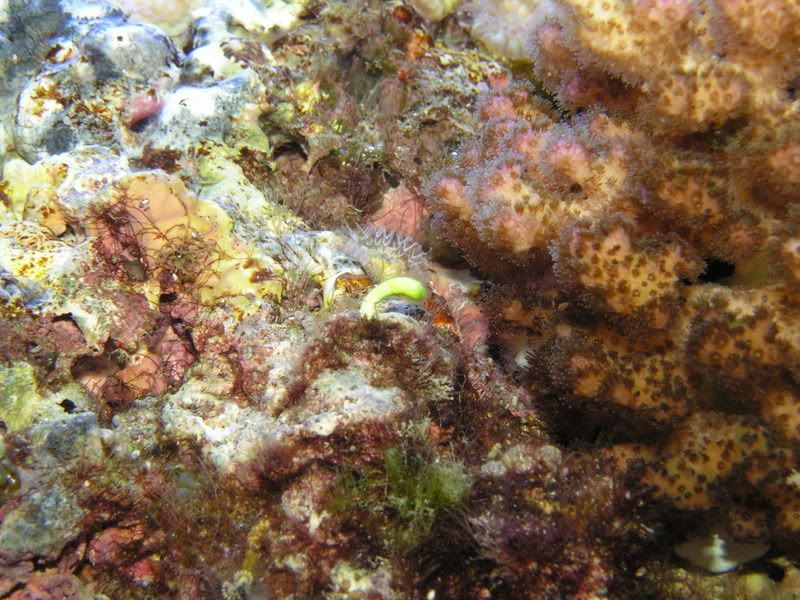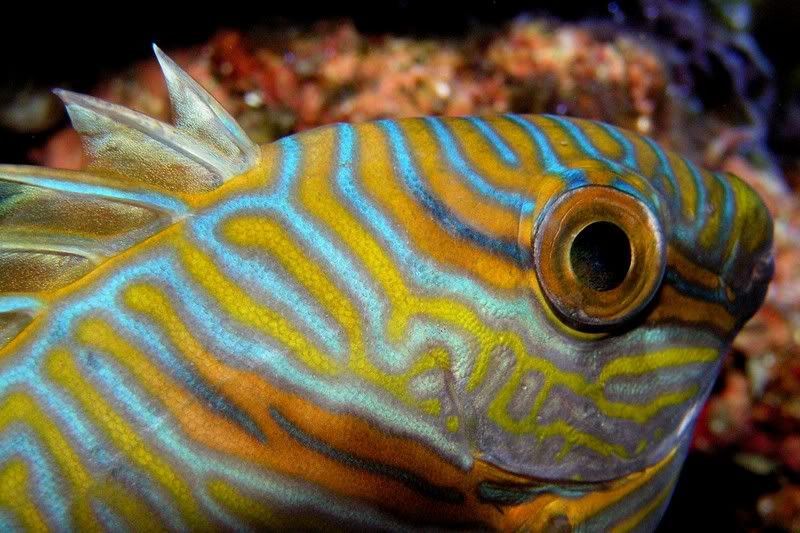-
Posts
490 -
Joined
-
Last visited
-
Days Won
1
Content Type
Profiles
Forums
Events
Store
Posts posted by DChemist
-
-
Yeah- welcome. It's a very nice start. How long has it been running?
-
I've got it too, but it's not very bad- I wonder if something is controlling it in my tank.
This isn't a great photo of it, but I think it starts out green and turns red as it ages.

-
I just googled - It looks a lot like Capnella
If it IS Capnella then I have to make sure I feed it, as it has less symbiotic algae. :(
I purposely avoid anything that lacks or has very limited zooxanthellae; My reef skills aren't up to that level.
I hope it'll do with one swish of a big swish of Cyclopeeze weekly, cuz that's my routine...unless any of you have a better suggestion...
I have what I beleive is Capnella- I don't target feed it but it is growing. You'll probably be fine.
-
It's hard to tell, but could be a Kenya Tree, Capnella.
-
Wasn't the question whether it was a Montipora or not?
-
Reefgeek- Is this what you are referring to?
http://whelk.aims.gov.au/coralsearch/html/201-300/Species%20pages/262.htm
http://www.reefermadness.us/RMD01198718.htm
If it is, it looks as if it's encrusting.
-
Rong666 introduced me to the club at Pets on Broadway, just before the summer BBQ at Steve Weast's. I've only attended meetings 2-3 times each year- even hosted my tank at the Northern tour. I spend most of my club time participating on this forum though I only jump in when I have something to contribute- I don't chat alot. I also enjoy everyone's photography. I've enjoyed the speakers-Tyree and Borneman. I do support our sponsors (Fanta-Seas, Waves and Upscales) though I have to admit some sponsors have been friendlier and more encouraging than others.
-
The rabbitfish is cleaning up on the bubble algae also. He's incredible.
-
I reseached it because I've been meaning to learn more about the little guy in my tank (and to be helpful, of course). I think I may start feeding mine to see how big it will grow.
-
And from Wet Web Media... http://www.wetwebmedia.com/shroomfaq3.htm
Ball Corallimorph - Pseudocornyactis 11/17/03
I have two questions for the knowledgeable crew of WWM -
if you can spare the time

1. A while back I found this cutesy little hitchhiker on my live rock (photo included). Can you tell what it is? The only possibility I came up with is a Corallimorpharian,
Pseudocorynactis sp. (although in the pictures the colors are
different).
This worries me a little, because Julian Sprung says in his book that the Indo-Pacific Pseudocorynactis will grow big and eat small fishes/mobile inverts (!)
I like the little fellow, but if he's shaping to be a fish eater, then I'd better nip him in the bud, so to speak. So it would be helpful if you could confirm - or refute - my identification.
2. I know you guys are against mixing different groups of corals (SPS, LPS, zoanthids etc)
- and it makes perfect sense when we're talking, say, about tabletop Acropora from the reef front being housed together with mushroom corals that naturally live in calmer, deeper waters.
But how about species from the same habitat? Say, Montipora
digitata and soft corals - all lagoon dwellers? Wouldn't it be natural to put them together?
I am asking because I have softies at the moment (the
beginner's obvious choice), but I would love to try Montipora one day - and then, barring a total re-haul of the tank, it would find itself among soft corals... What is your opinion of that combination?
All the best Anka from Poland (a dedicated fan of your great site
 )
) -
From Advanced Aquarist... http://www.advancedaquarist.com/issues/oct2002/invert.htm
Pseudocorynactis
Pseudocorynactis spp. are like Corynactis but are much larger (to about six inches (15 cm) diameter, and usually not colonial. They also reproduce by fission, but it is unusual to find more than about six clones together as a group. The so-called orange ball anemones that can be observed on coral reefs at night are Pseudocorynactis spp. The column varies in color from cryptic shades of brown to orange, red and magenta. The tips of the tentacles are commonly bright orange, but they can also be white. These tentacle tips are extremely sticky, like flypaper, due to the presence of powerful nematocysts. This fact makes the larger species from the Indo Pacific region unsuitable for aquariums housing fishes, which they readily capture. They also can catch mobile invertebrates such as shrimps and snails, and sometimes "attack" sessile invertebrates growing on adjacent rocks, enveloping them in the gastric cavity through a widely opened mouth. Pseudocorynactis spp. can be fed daily, but only require twice weekly feeding to keep them healthy. If they are not fed frequently enough, they shrink. There is a marked behavioral difference between the common Caribbean and Indo-Pacific species.
The Caribbean species, Pseudocorynactis caribbaeorum mainly opens its tentacles at night, and closes rapidly when it senses light. The Indo-Pacific species remains open both day and night, and is not sensitive to light. The presence of food smells (dissolved amino acids) in the water stimulates either species to open up and extend the tentacles, and the caribbean species can be trained to open in the light by feeding it during daylight hours. The mechanism for its apparent memory is not known.
Whether you have a large reef aquarium or a simple small aquarium, any of the corallimorphs can be easily maintained and enjoyed for decades.
-
I have one that lives in the sand bed and only comes out at night. Appears harmless- but then again, he's not living real close to anything I really value.
-
It is amazing to watch the color recovery. One acro of mine was a brown-out sale item that I could never get to color up. During the crash it totally bleached white and I thought I lost it. It's recovering to a nice blue color.
-
Was whatever happened real specific to your Monti's? After my recent crash, while I thought I lost my monti's, most have made a pretty good recovery.
-
DChemist: Are you actually a chemist? If so, what is the equation they might have used in that calculator? I'm curious.
Here are my credentials- I have an associates degree in Chemistry Technology from Clark Community College that allowed me to work as a chemistry technician (at a Chlor-Alkali plant in Portland) while I finished College at the University of Portland. I graduated with a major in biology and a minor in chemistry. I worked as a QC chemist for a year before I worked as a formulations chemist for the next eight years. Since 2000, I progressively became more involved in IT, which I'm now doing full time for a large chemical distributor.
I haven't followed the links yet so I'm not sure what equations the're using- but I've built a similar tool used in adjusting heat transfer solutions (glycol in water). Just offering to help if help was needed.
-
There were three links, save us some time and tell which one was best for you...
-
Both fish gone...
Anyone interested in freshwater plants?
-
Let me know if those links work for you- if not give me a PM with what you're trying to do exactly (starting gravity, finish gravity, starting volume of saltwater, finish volume of saltwater, etc) I could help you calculate it.
-
I use a 10 ml syringe with a narrow tip (from the dentist- used for irrigating after getting wisdom teeth out). I hit them with about .25 ml of 1 N sodium hydroxide, then use the syringe to suck out the body parts. It works well, its several months before I see any recurrence but with aiptasia I don't think anything is permanent.
-
Another Photo
Those are very cool fish! Mine is getting bigger everyday and they have a different personality about them. Mine will stick is nose out of the water' date=' like he wants you to pet him, but the spines have stopped me from trying. :p DOH! (scratch)[/quote']Yeah- they're cool. The spines are intimidating. Here's a close-up that I took a couple of days ago.

-
I had a bunch when I started in the hobby- came in on the rocks and spread everywhere. They ultimately went away naturally without anything I did.
If they aren't damaging anything, personally I'd leave them.
-
I was kind of thinking about Steve's display when I posted the question. His is the most colorful display I've seen (thanks to the summer BBQ). As well as a well-defined philosophy.
-
"a very unrealistic but stunningly colorful group of tanks and corals in Oregon - the kind most reefkeepers dream of having"
An interesting quote. I'm wondering what everyone is trying to achieve with their own reef tanks; realistic, stunningly colorful, diverse, species tank, etc?
I'll have to come up with a "mission statement" for my own tank and share...
-
I don't have experience with the sailfin tang- I haven't seen my rabbitfish touch the bubble algae (or the zoa's either).



Tank is recovering-LOTS of pics.
in General Discussion
Posted
Not to be cofused with M. Confusa
http://whelk.aims.gov.au/coralsearch/html/401-500/Species%20pages/458.htm
(naughty)